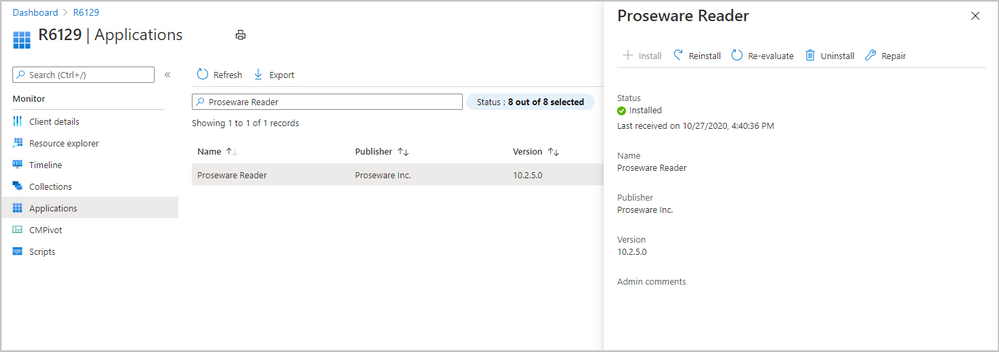
by Contributed | Oct 30, 2020 | Technology
This article is contributed. See the original author and article here.
This month we have a second technical preview. Update 2010.2 for the Technical Preview Branch of Microsoft Endpoint Configuration Manager has been released.
We’ve made improvements to applications for tenant attached devices. Administrators can now do the following actions for applications in the Microsoft Endpoint Manager admin center:
- Uninstall an application
- Repair installation of an application
- Re-evaluate the application installation status
- Reinstall an application has replaced Retry installation
 application actions for tenant attached device
application actions for tenant attached device
Learn more about Enhancements to applications in Microsoft Endpoint Manager admin center.
This preview release also includes:
Tenant attach: Troubleshooting portal lists a user’s devices based on usage – The troubleshooting portal in Microsoft Endpoint Manager admin center allows you to search for a user and view their associated devices. Starting in this release, tenant attached devices that are assigned user device affinity automatically based on usage will now be returned when searching for a user.
Tenant attach: Create and deploy firewall policies – You can now configure and deploy settings for Windows Defender Firewall with Advanced Security to tenant attached Windows 10 devices.
Enhancements to applications in Microsoft Endpoint Manager admin center – We’ve made improvements to applications for tenant attached devices. Administrators can now do the following actions for applications in the Microsoft Endpoint Manager admin center:
- Uninstall an application
- Repair installation of an application
- Re-evaluate the application installation status
- Reinstall an application has replaced Retry installation
Improvements to BitLocker management – Based on your UserVoice feedback, you can now manage BitLocker policies and escrow recovery keys over a cloud management gateway (CMG). This change also provides support for BitLocker management via internet-based client management (IBCM) and when you configure the site for enhanced HTTP. There’s no change to the setup process for BitLocker management.
Improvements to deploy an OS over CMG using boot media – This release streamlines the administrative workflow in the Configuration Manager console. On the Media Management page of the Create Task Sequence Media Wizard, the Internet-based media option no longer exists. Select the Site-based media option. Then still select the CMG for the management point on the Boot Image page.
Desktop Analytics support for new Windows 10 data levels – Microsoft is increasing transparency by categorizing the data that Windows 10 collects:
- Basic diagnostic data is recategorized as Required diagnostic data
- Full is recategorized as Optional
If you previously configured devices for Limited or Limited (Enhanced), in an upcoming release of Windows 10, they’ll use the Required level. This change may impact the functionality of Desktop Analytics. Configuration Manager will properly configure the devices. If you’re using another mechanism to configure these policies on devices, you may need to make changes for the upcoming new behavior.
Immediate distribution point fallback for clients downloading software update delta content – There’s a new client setting for software updates. If delta content is unavailable from distribution points in the current boundary group, you can allow immediate fallback to a neighbor or the site default boundary group distribution points. This setting is useful when using delta content for software updates since the timeout setting per download job is 5 minutes.
Disable Azure AD authentication for onboarded tenants – You can now disable Azure Active Directory (Azure AD) authentication for tenants not associated with users and devices. When you onboard Configuration Manager to Azure AD, it allows the site and clients to use modern authentication. Currently, Azure AD device authentication is enabled for all onboarded tenants, whether or not it has devices. For example, you have a separate tenant with a subscription that you use for compute resources to support a cloud management gateway. If there aren’t users or devices associated with the tenant, you can now optionally disable Azure AD authentication.
Additional options when creating app registrations in Azure Active Directory – You can now specify Never for the expiration of a secret key when creating Azure Active Directory app registrations.
Validate internet access for the service connection point – If you use Desktop Analytics or tenant attach, the service connection point now checks important internet endpoints. These checks help make sure that the cloud-connected services are available. It also helps you troubleshoot issues by quickly determining if network connectivity is a problem.
Improvements to the administration service – The Configuration Manager REST API, the administration service, requires a secure HTTPS connection. With the previous methods to enable HTTPS, enabling IIS on the SMS Provider was a prerequisite. Starting in this release, you no longer need to enable IIS on the SMS Provider for the administration service. When you enable the site for enhanced HTTP, it creates a self-signed certificate for the SMS Provider, and automatically binds it without requiring IIS.
Update 2010.2 for Technical Preview Branch is available in the Microsoft Endpoint Configuration Manager Technical Preview console. For new installations, the 2010 baseline version of Microsoft Endpoint Configuration Manager Technical Preview Branch is available on the Microsoft Evaluation Center. Technical Preview Branch releases give you an opportunity to try out new Configuration Manager features in a test environment before they are made generally available.
We would love to hear your thoughts about the latest Technical Preview! Send us Feedback about product issues directly from the console and use our UserVoice page for ideas about new features.
Thanks,
The Configuration Manager team
Configuration Manager Resources:
Documentation for Configuration Manager Technical Previews
Try the Configuration Manager Technical Preview Branch
Documentation for Configuration Manager
Microsoft Endpoint Manager announcement
Microsoft Endpoint Manager vision statement
Configuration Manager Forums
Configuration Manager Support
by Scott Muniz | Oct 30, 2020 | Security, Technology
This article is contributed. See the original author and article here.
Original release date: October 30, 2020 | Last revised: November 3, 2020
This advisory uses the MITRE Adversarial Tactics, Techniques, and Common Knowledge (ATT&CK®) version 8 framework. See the ATT&CK for Enterprise version 8 for all referenced threat actor techniques.
This joint cybersecurity advisory was coauthored by the Cybersecurity and Infrastructure Security Agency (CISA) and the Federal Bureau of Investigation (FBI). CISA and the FBI are aware of an Iranian advanced persistent threat (APT) actor targeting U.S. state websites—to include election websites. CISA and the FBI assess this actor is responsible for the mass dissemination of voter intimidation emails to U.S. citizens and the dissemination of U.S. election-related disinformation in mid-October 2020. This disinformation (hereinafter, “the propaganda video”) was in the form of a video purporting to misattribute the activity to a U.S. domestic actor and implies that individuals could cast fraudulent ballots, even from overseas. https://www.odni.gov/index.php/newsroom/press-releases/item/2162-dni-john-ratcliffe-s-remarks-at-press-conference-on-election-security. (Reference FBI FLASH message ME-000138-TT, disseminated October 29, 2020). Further evaluation by CISA and the FBI has identified the targeting of U.S. state election websites was an intentional effort to influence and interfere with the 2020 U.S. presidential election.
Click here for a PDF version of this report.
This product is provided subject to this Notification and this Privacy & Use policy.

by Contributed | Oct 30, 2020 | Technology
This article is contributed. See the original author and article here.
In the spirit of Halloween, the Ghost of Roadmap Past shall be your guide – helping you to avoid becoming a Roadmap Scrooge. It’s a Dickens of a blog, all to help get you up-to-speed on everything recently released out into Microsoft 365 for SharePoint and related tech– including a few Ebenezer Teasers from our friend, the Ghost of Roadmap Future.
October 2020 brought some great new offerings: SharePoint Syntex, Organization Chart web part, new IT controls for Microsoft Lists, Microsoft Lists – commenting, OneDrive widget for iPhone, Task in Teams GA, and more. Details and screenshots below, including our audible, “ghostly-spirited at times” companion: The Intrazone Roadmap Pitstop: October 2020 podcast episode – all to help answer, “What’s rolling out now for SharePoint and related technologies into Microsoft 365?”
In the podcast episode, I chat with Harsh Agarwal (LinkedIn), program manager at Microsoft on the Microsoft Teams engineering team. I talked with Harsh about the new file sharing experience in Teams channels and chat and the broader notion of a consistent file sharing experience across Microsoft 365.
![IZ-RP-24_001_Harsh-Agarwal-profile.jpg Harsh Agarwal, program manager (Teams / Microsoft) [Intrazone guest]](https://techcommunity.microsoft.com/t5/image/serverpage/image-id/230448iD80F9D83CE8CCF1E/image-size/large?v=1.0&px=999) Harsh Agarwal, program manager (Teams / Microsoft) [Intrazone guest]
Harsh Agarwal, program manager (Teams / Microsoft) [Intrazone guest]
All features listed below began rolling out to Targeted Release customers in Microsoft 365 as of October 2020 (possibly early November 2020).
Inform and engage with dynamic employee experiences
Build your intelligent intranet on SharePoint in Microsoft 365 and get the benefits of investing in business outcomes – reducing IT and development costs, increasing business speed and agility, and up-leveling the dynamic, personalized, and welcoming nature of your intranet.
SharePoint Syntex
This is the first product to come from Project Cortex – a broader Microsoft 365 initiative, that applies advanced artificial intelligence (AI) to empower people with knowledge and expertise in the apps they use every day.
Syntex amplifies human expertise, automates content processing, and transforms content into knowledge. Syntex mainstreams machine teaching, enabling your experts to capture their knowledge about content in AI models they can build with no code.
Your experts train Syntex to understand content like they do, to recognize key information, and to tag content automatically. For example, a contract processing expert can teach the service to extract the contract’s value, along with the expiration date and key terms and conditions.
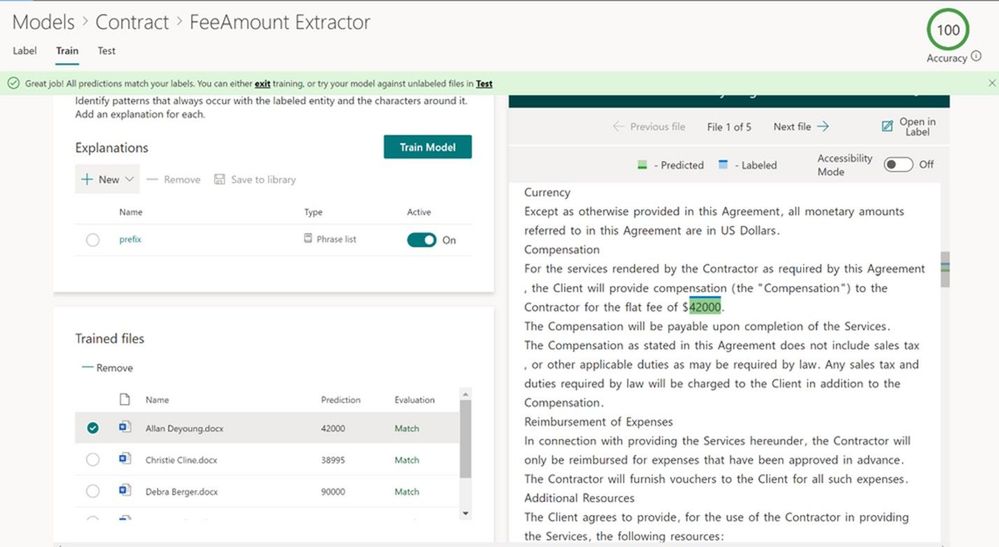 SharePoint Syntex can automatically suggest or create metadata, extraction as a part of ‘document understanding.’
SharePoint Syntex can automatically suggest or create metadata, extraction as a part of ‘document understanding.’
Organization Chart web part
Visibility on hierarchy answers many questions on who’s who and who knows what. This web part allows page authors to generate an organization chart based off of a specific individual – just type in their name. The page author will have the option to determine how many levels up this org chart goes, and as you navigate, you’ll see who reports to who.
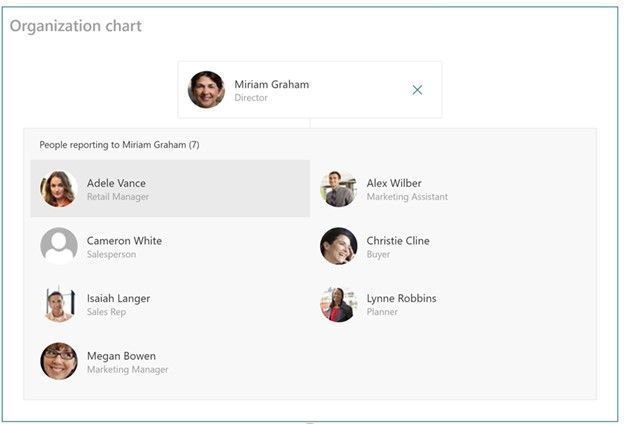 For users with edit permissions, the web part will be available in the web part toolbox when a page is in edit mode. Page consumer can then click on a person’s name or photo to learn more and navigate.
For users with edit permissions, the web part will be available in the web part toolbox when a page is in edit mode. Page consumer can then click on a person’s name or photo to learn more and navigate.
IT control setting for Microsoft Lists
Governance depends on who can do what and what they can do. Based on Microsoft 365 admin feedback, we added new IT capabilities, along with new documentation, on how you can better manage *Microsoft Lists* via #PowerShell.
This means you can:
- Control the creation of personal lists – a disable control, and
- Manage the built-in, ready-made templates – so that only the ones you wish to be available to your people will appear.
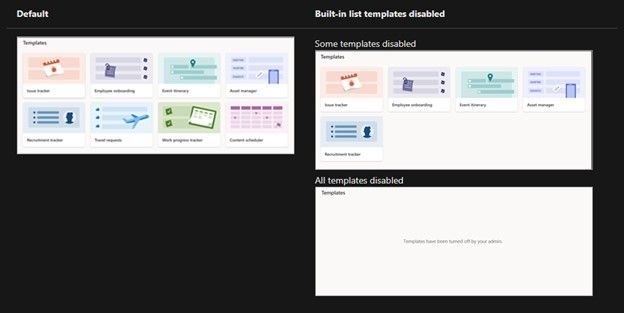 Disabling ready-made list templates removes them from all places people create lists (the Lists app, within Microsoft Teams, and within SharePoint sites).
Disabling ready-made list templates removes them from all places people create lists (the Lists app, within Microsoft Teams, and within SharePoint sites).
Learn more.
Teamwork updates across SharePoint team sites, OneDrive, and Microsoft Teams
Microsoft 365 is designed to be a universal toolkit for teamwork – to give you the right tools for the right task, along with common services to help you seamlessly work across applications. SharePoint is the intelligent content service that powers teamwork – to better collaborate on proposals, projects, and campaigns throughout your organization – with integration across Microsoft Teams, OneDrive, Yammer, Stream, Planner and much more.
New Teams file sharing experience
Share files on your terms. You can now create a shareable link for any file stored in Teams and directly set the appropriate permissions. Additionally, you can also set permissions for files stored in SharePoint or OneDrive while composing a private chat or starting a channel conversation.
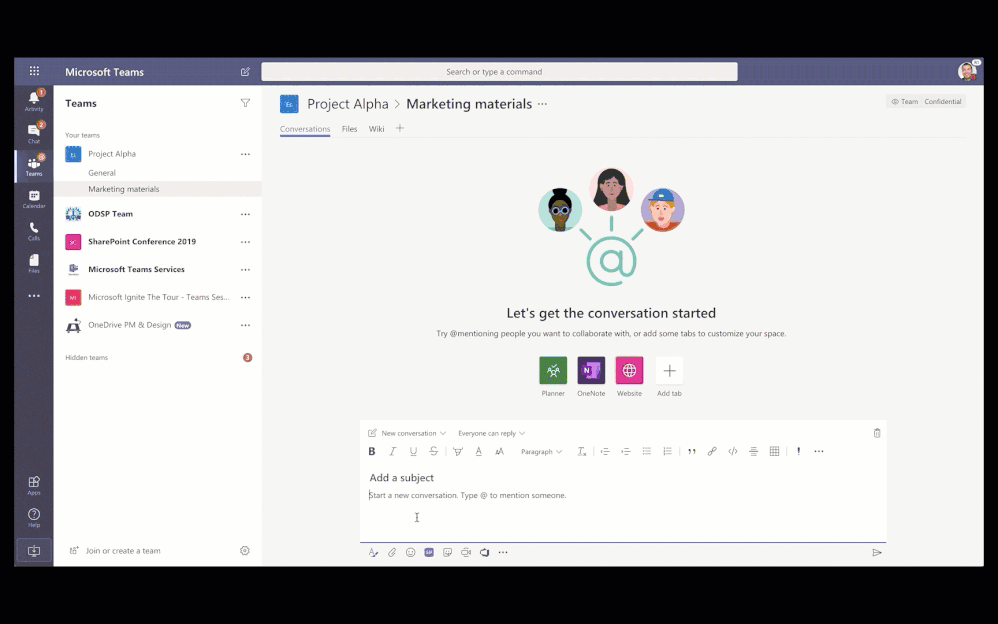 The new file sharing experience in Teams adheres to set policies and give people the flexibility to share the way they want to share.
The new file sharing experience in Teams adheres to set policies and give people the flexibility to share the way they want to share.
The copied link can then be shared with others, by pasting it into a chat or channel. On pasting the plain lengthy link, this feature converts the link into a visual file chiclet/image. The sender can also set permissions on the file link that they are sharing, at the time of composing the message itself, so that the recipients do not run into access issues.
Microsoft Lists – commenting
Have something to say? Say it. And say it in a native, natural way without breaking privacy or compliance policy. You will be able to add and delete comments on list items. Users can view all comments on a list item and filter between views that show comments or activity related to an item.
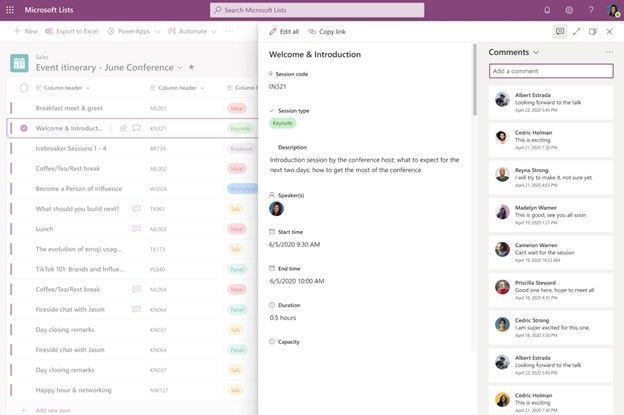 Add and delete comments on list items.
Add and delete comments on list items.
Note: comments follow the permission settings inherent in SharePoint and Microsoft Lists. Users with read-only permission can only view comments. Those with list edit permission can make comments as well as delete comments; editing comments is currently not possible.
A few FYI notes on “where and how are comments stored”:
- Comments are stored in the schema for each list, which is based on the SharePoint storage platform.
- If you are using a classic list template, it will not have this commenting feature.
- Commenting on lists in Teams is not yet available; currently leverage Teams chat for lists in Teams.
- And last, comments are not indexed by Microsoft Search.
Related technology
OneDrive widget for iPhone
Now, when you run iOS14 on your device, you can add a OneDrive widget to your iPhone home screen. The widget displays your photo memories “on this day” across previous years. And, if you don’t have any On This Day photos for today, you’ll see your most recent photos that you’ve saved to the cloud.
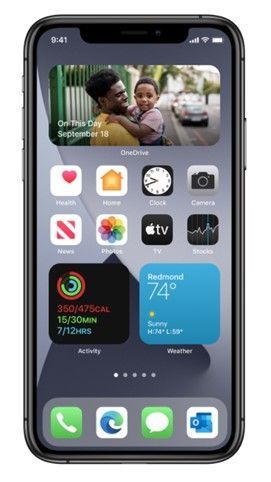 The new OneDrive widget on iOS14 shows your photo memories on this day across previous years.
The new OneDrive widget on iOS14 shows your photo memories on this day across previous years.
Note: this feature is only available for personal OneDrive accounts (home and family).
Tasks in Microsoft Teams is now generally available
Tasks in Microsoft Teams desktop and web is now 100% rolled out to everyone with a Microsoft 365 subscription across all non-government tenants. Tasks in Teams lets you manage your team tasks from Planner and individual tasks from To Do in your hub for teamwork.
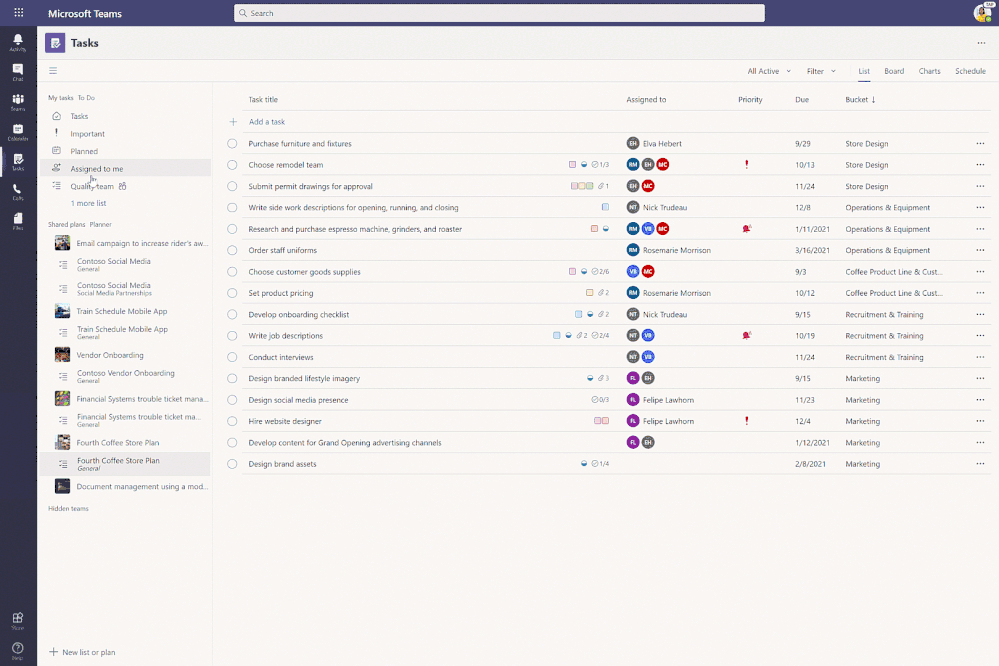 Tasks in Teams lets you manage your team tasks from Planner and individual tasks from To Do in your hub for teamwork.
Tasks in Teams lets you manage your team tasks from Planner and individual tasks from To Do in your hub for teamwork.
Note: We’re working to make Tasks in Teams available for our government cloud offerings, with GCC going live in the coming months. GCC High and DoD will follow that.
Embed Visio files, stored in OneDrive or SharePoint, into pages in Atlassian Confluence
We’re excited to announce our first-ever non-Microsoft integration for Visio with Atlassian Confluence, a remote-friendly team workspace.
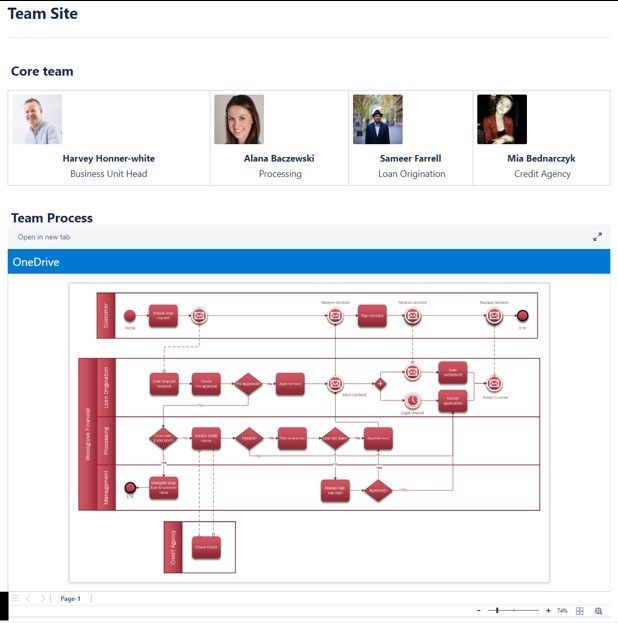 Atlassian Confluence connects to your Microsoft 365 account (OneDrive and SharePoint storage) to display a dynamic preview of the Visio file with governance and permissions intact.
Atlassian Confluence connects to your Microsoft 365 account (OneDrive and SharePoint storage) to display a dynamic preview of the Visio file with governance and permissions intact.
Alongside embedding Word, Excel, or PowerPoint files, you can also easily add Visio diagrams to your Confluence pages – to then open them directly in a new browser tab – keeping the files where they are in Microsoft 365.
Your data remains secure—Confluence respects all privacy settings set in OneDrive and SharePoint, so no unauthorized users can access your content.
November 2020 ‘Ebenezer’ teasers
Psst, still here? Still scrolling the page looking for more roadmap goodness? If so, here is a few teasers of what’s to come to production next month that are sure to put Jacob Marley at bay…
- Teaser #1: My Feed web part [Roadmap ID: 67148]
- Teaser #2: SharePoint Site performance page [Roadmap ID: 66196]
… shhh, tell everyone – especially Tiny Tim Cratchit.
Helpful, ongoing change management resources
- Follow me to catch news and interesting SharePoint things: @mkashman; warning, occasional bad puns may fly in a tweet or two here and there.
Thanks for tuning in and/or reading this episode/blog of the Intrazone Roadmap Pitstop – October 2020 (blog/podcast). We are open to your feedback in comments below to hear how both the Roadmap Pitstop podcast episodes and blogs can be improved over time.
Engage with us. Ask those questions that haunt you. Push us where you want and need to get the best information and insights. We are here to put both our and your best change management foot forward.
Stay safe out there on the ghostly road’map, and thanks for listening and reading.
Happy Hallowed Eve,
Mark Kashman – senior roadmap ghost manager (SharePoint/Lists) | Microsoft)
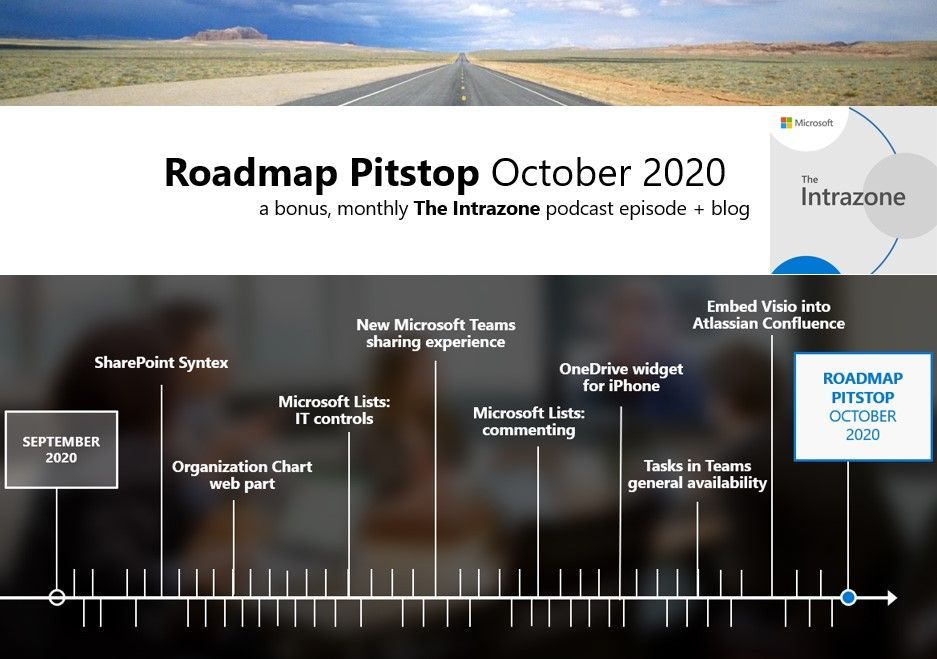 The Intrazone Roadmap Pitstop – October 2020 graphic showing some of the highlighted release features.
The Intrazone Roadmap Pitstop – October 2020 graphic showing some of the highlighted release features.
by Contributed | Oct 30, 2020 | Technology
This article is contributed. See the original author and article here.
Students join the Microsoft Learn Student Ambassador program for all kinds of reasons, and when they get here, they have big plans.
We wanted to share insights from our Student Ambassador community about how and why they joined, what technologies they’re curious about, and how they’re working to build and contribute to the tech community. We asked, and Student Ambassadors from around the world answered.
“So, what brings you here?”
Students learn about the Student Ambassador program through tech events, school faculty, LinkedIn, and, of course, fellow students who are already in the program. But why do they decide to apply?
Most of the Student Ambassadors we heard from were drawn to the program because they’re passionate about technology, which wasn’t a huge surprise. Beyond that, though, each of them also has their own unique reasons for joining. Here’s why some students apply to become Student Ambassadors:
They want to learn something new and develop their skills.
“I felt very inspired by a senior from my university who was already a Microsoft Student Ambassador. She told me all about its perks and the ample amount of experience and knowledge we get to learn, which led me to apply for this program.”
Eva Thakran, fourth-year student at the Manav Rachna International Institute of Research and Studies
|
They’re excited to collaborate with other passionate students and build a global network.
“I love to learn about cultures of different countries and regions, so what is better than a global community of students?”
Shashank Kanojiya, second-year student at the Indian Institute of Information Technology
|
They see the value in sharing their knowledge and evangelizing technology.
“I wanted to become a better version of myself by helping others to learn new technologies.”
Christina Pardali, fifth-year student at Aristotle University of Thessaloniki
|
They aim to create meaningful impact and solve global problems.
“I found the Student Ambassador program to be full of like-minded individuals who share an equal passion for a better world with the help of technology.”
Basu Singh, first-year student at ITI Institute
|
They want to connect with experts at a well-known company.
“I realized that if I wanted to learn from professionals, I should hitch my wagon to Microsoft.”
Joaquín García Benítez, first-year master’s student at KTH Royal Institute of Technology
|
“What technologies are you and your community curious about?”
Microsoft Learn Student Ambassadors are deeply invested in learning as much as they can about the technology that catches their interest. They’re naturally curious, and they love diving into emerging topics and tools. (Maybe you can relate? ;))
Here’s what they’re currently exploring:
- Cloud computing (including Azure)
- The Internet of Things (IoT)
- Autonomous systems
- AI
- Machine learning
- Deep learning
- Automation (including Power Apps and Microsoft Power Platform)
- Low-code development
|
- Databases
- Data science and big-data analytics
- Image processing
- Python
- User experience and UI design
- Cybersecurity
- Web development
- Mobile app development
- Microsoft 365
|
“At this moment, I am curious about web development, mobile applications development, autonomous systems, and cloud platforms.”
Joaquín García Benítez, first-year master’s student at KTH Royal Institute of Technology
|
“My tech community nowadays is more focused towards cybersecurity and big data—how to handle and store big data. I am curious about AI and cybersecurity techniques.”
Eva Thakran, fourth-year student at the Manav Rachna International Institute of Research and Studies
|
“I am interested mostly in all Microsoft new technologies, such as core programming, AI, IoT, Microsoft Power Platform, Dynamics 365, machine learning, and data science. All those technologies are empowering and have something in store for the future.”
Lablonde Juliette Kalalizi, third-year student at the Durban University of Technology
|
“How do you hope to expand your knowledge or your community through the Microsoft Learn Student Ambassador program?”
The current Student Ambassador cohort is navigating a global reality that makes in-person events and conversations difficult, if not impossible. But that isn’t stopping them from serving their communities.
Whether they’re just getting started or they’ve been in the program for a while, these Student Ambassadors are working hard to connect and inspire their colleagues:
“I will conduct workshops and events, help my fellow students explore the field of technology, and inspire them to find possible solutions to humanitarian issues through technology.”
Foteini Savvidou, third-year student at Aristotle University of Thessaloniki
|
“I have two technical communities at my college, and I am General Secretary of one of them, proudly leading a group of 60 students. We are a very diverse community.”
Nandita Gaur, final-year student at ABES Engineering College
|
“My community has grown fast. In my community, there are not only computer scientists—we also have accounting, law, and administration students. I also created a community with teachers from my country (Peru) for Microsoft 365 topics, to learn with Microsoft Educator Center, and I see several improvements so far.”
Eduardo Salazar, final-year student at the Instituto ISAM
|
“First, I start by recommending my community to complete the courses that are available in Microsoft Learn to have a fundamental basis about the technology that interests them and then be able to advance. They are all very committed to seeing in themselves the progress they are making and, above all, learning new things.”
Leydi Rosmery Aylas Curi, final-year student at the Peruvian University of the Americas
|
What’s a fun fact about yourself that you want to share with others?
“I love making paintings and baking various kinds of cakes. I am pretty good at mehendi design, an Indian style of tattoo art.”
Nandita Gaur, final-year student at ABES Engineering College
|
“When I was a child, I wanted to be a teacher or an actress. Maybe this is the reason that I became a Microsoft Learn Student Ambassador, so I can have the chance to help my fellow students and present on the stage about technology.”
Maria-Anastasia Moustaka, fifth-year student at University of Patras (Greece)
|
“When I applied at university, I wanted to become a civil engineer. I am grateful that I decided to study ICT programming because it’s helped me find my passion in technology and leadership—and becoming a Microsoft Student Ambassador has helped be become a better version of myself.
Lablonde Juliette Kalalizi, third-year student at the Durban University of Technology |
Your turn! How would you build community as a Student Ambassador?
Becoming a Microsoft Learn Student Ambassador opens doors near and far. If you were connected to a group of people who were just as passionate as you are about learning, growing, and using technology for good, where would you start?


![IZ-RP-24_001_Harsh-Agarwal-profile.jpg Harsh Agarwal, program manager (Teams / Microsoft) [Intrazone guest]](https://techcommunity.microsoft.com/t5/image/serverpage/image-id/230448iD80F9D83CE8CCF1E/image-size/large?v=1.0&px=999)

Recent Comments